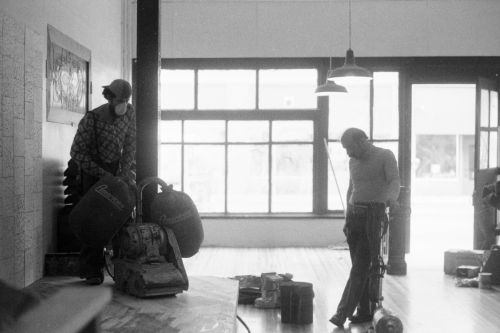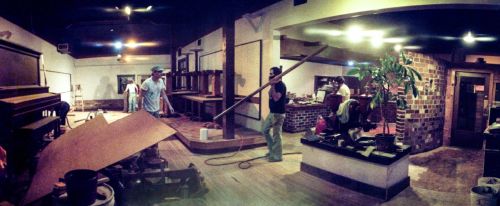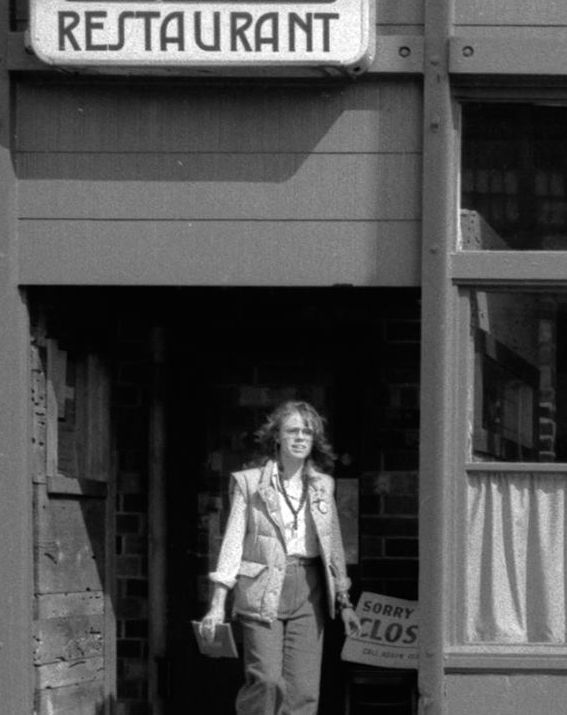WORK
Laura May Abraham Booker and Rainbow Grocery/Restaurant
Excerpted from a 1988 Interview by Stephen Charak [1953 – 2004]
Originally published in Olympia: Voices

Stephen Charak: In March of 1974, Laura May was approached by the owners of a restaurant called the Artichoke Mode, a restaurant (located in the 200 block of West Fourth Avenue) that has gone through a number of owners and name changes since then.
Laura May Booker: They said, “Hey Laura May, there’s a grocery store for sale across the street.” I said, “What do I want a grocery store for?” Still, [I] went to look at the store. We looked in the windows, and boy was it a dive. It was a cigarette and beer stop. The drunks would stumble between Ben Moore’s and the Angelus Hotel. But still, it was a functional grocery store. Andrew had the background of being raised in [the grocery] business. His mother had a place in Hurley, Wisconsin, close to the shore of Lake Superior since 1940. And I had the experience of being the manager of a Food Co-op. So this vacant grocery store presented a great opportunity.
Stephen: Andrew and Laura May were married in 1970. She was nineteen.
Laura May: We had a beautiful wedding in San Diego. Then we went and took off cross country. Andrew told me later that my father had him make a promise that I would never work in the bar. My father knew it was a [Abraham] family business, but he didn’t want me to be in a bar. My family did not go to bars.
Stephen: Still, once they arrived in Hurley, Laura May went to work in the bar.
Laura May It was a family business. And Andrew’s mother was the kind who would cook delicious food for her customers. The pipeline had gone through town, so the workers all came to her bar. She had guys from Louisiana (workers from the pipeline) who would send her presents years later. She’d say, “Honey, you know you’re my favorite boy!’ This is how she took care of people. She fed them. She made them feel very special. That’s where I learned that. His mother provided me with my whole business training.
Stephen: When they looked into the grocery store they learned that there was a beer license also for sale.
Laura May: Andrew knew the value of that. The business—that grocery store with everything in it and beer license—cost $4,000. We applied for the transfer of the beer license and we opened on May 10, 1974. We had a grocery store!
Stephen: Laura May was taken with the history of the place.
Laura May: When we came in there, it looked essentially like it did in the 1930s. [She pointed to some of the old photographs on the wall of her kitchen.] The same shelves on the wall. The same cabinets on the floor. The old Post Office was there, where the safe was. I found old shellfish licenses from the 1930s. I thought this was a really privileged position to be in, maintaining this old corner grocery store in the heart of town.
Stephen: She never planned to make changes at what she and Andrew called the Rainbow Grocery.
Laura May: This was like a natural extension of moving out of the Co-op and into this place. And I thought it was a really good job. I could run it by myself, but I didn’t. It was a co-op in a sense. A group of people worked there. Andrew and I lived in a farmhouse at the time. For the second time in our early marriage history, we wound up living with about four or five other people, one was a guy from a restaurant family.
It was a place where people ate. We sold these really great sandwiches. They were dynamite sandwiches. We made them with Gai’s pumpernickel rolls. We had a Tony’s Pizza oven, and that’s where I cooked my sandwiches. We would put in fresh mushrooms and green pepper and sprouts and onion and any one of a great variety of cheese. We had salami and other meat. We had a great carrot cake that Gai’s bakery made. We had this bran bread that people still ask me for.
Stephen: Andrew had other ideas for the Rainbow.
Laura May: I give Andrew total credit. He created the vision of what that place was to become, and he executed that vision. The Rainbow was built from all corners of the universe, it was an evolution.
Andrew used to have a joke with me about how many rooms I could work in at once. First, we had the grocery store, and I sold coffee beans, raw milk and cheeses, because there was no co-op [at the time]. In February of 1977, we closed the grocery store. I ranted and raved because there was too much sentiment in the grocery story for me to let it go. I cried and I hollered, but over time I was convinced that the higher use of that corner was to be a restaurant. We opened the dining room in March of 1977. The dining room door was the main door, and it was walled off [from the grocery store] at that time. The dining room had the old Post Office with the old sliding window that went up and down and an old safe that I traded to the Brotherhood Tavern (located two blocks from the Rainbow) for an old coffee grinder that is down there now. I think that’s the same one that’s in one of the old photographs from when the George family had the store. They had it before the High brothers owned it from 1934 to 1970.

Eventually, we opened up the wall to the dining room and I worked in the kitchen. Some friends from New York showed us how to make pizza, so in July of that year we opened the pizza kitchen.
Stephen: As one section of the Rainbow Restaurant was being completed, Laura May worked in the other section. While the grocery store was open, the restaurant was being built. While the restaurant was open, the bar was being built.
Laura May: We finally opened the bar in October of 1979. It was a great place. Andrew had worked day in and day out for a year to finish building the bar. He was a genius. We had no money, so we had to build it twenty bucks at a time by squeezing it out of the restaurant. Finally, in October 1979, we opened the door. The place packed up. We had a great business in that bar. In 1979, ’80 and ’81, I had better business than I have had in the last couple years. The downtown competition sprang up after that.

Stephen: A rejuvenated Ben Moore’s opened up half a block down the street. Crackers moved onto Fourth Avenue a few blocks further east.
Laura May: Business was good then, but I couldn’t keep up with it.
Stephen: In January of 1982, Andrew and Laura May bought the Angelus Hotel upstairs from the Rainbow.
Laura May: That was beyond any of my wildest imaginations. It took me a year to acknowledge what that was all about. Andrew worked in the Restaurant and I ran the hotel.
Stephen: Their marriage ended, however.
Laura May: Andrew left in July of 1984. He left under emotional duress, and for the next year I mourned his loss, because he had always been there. He always had a good word for me. He was always supportive of me. I could always call on him and say, ‘This is falling apart, can you do something about it? Can something be done about the plumbing?’ So he really handled half of everything. Now we marvel at the life of the kitchen, because it was all meant to be temporary. The six burner stove was built out of an old kitchen table. And the range Andrew dragged up from somewhere that didn’t work and should have gone to dust. He knew how to put stuff together and make it work. Mrs. Davis of the Brown Derby sold us our pizza oven for $75 dollars, with about 15 feet of copper pipe. Andrew made it work. The copper pipe alone was worth $75.
Stephen: Then there was the hotel.
Laura May: I took over the hotel, without knowing what it was about, without knowing what I was really supposed to do there.
Stephen: Somehow, Laura May ran the hotel as apartments, as well as the restaurant.

Read the full transcript: Laura May Abraham—Section from Olympia: Voices © 1988 S. Charak
We encourage readers to contact us with comments and corrections. Disclaimer

